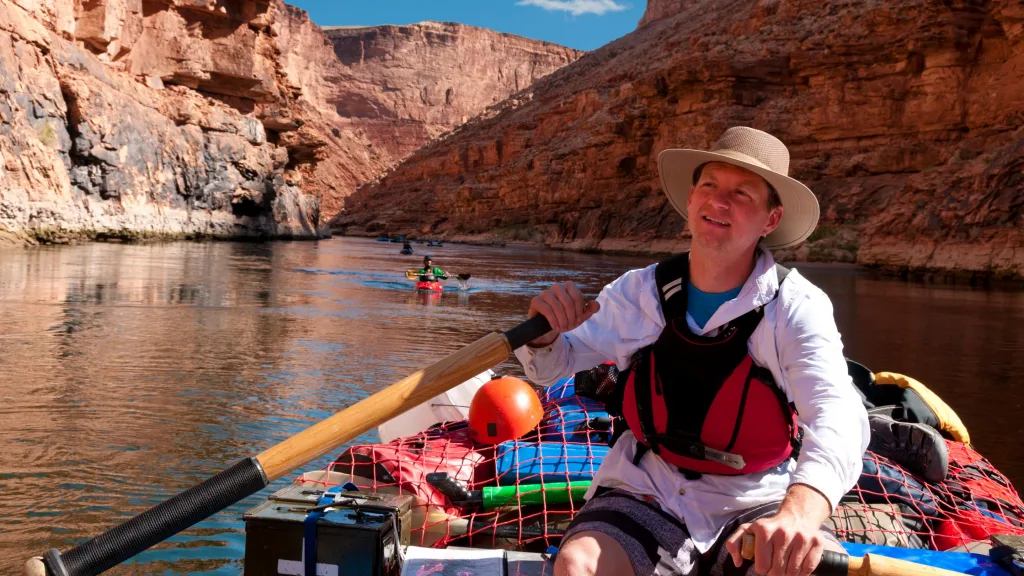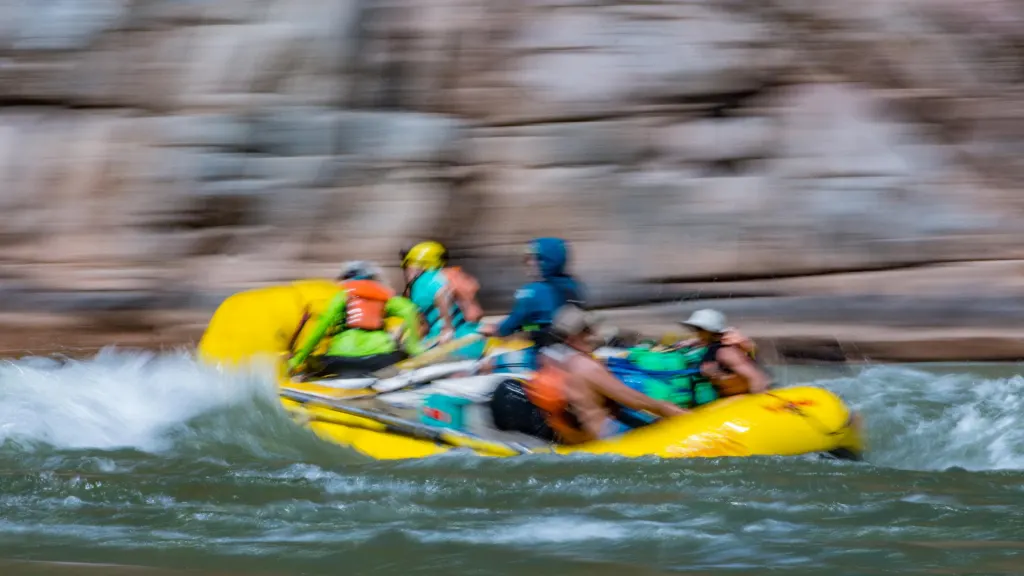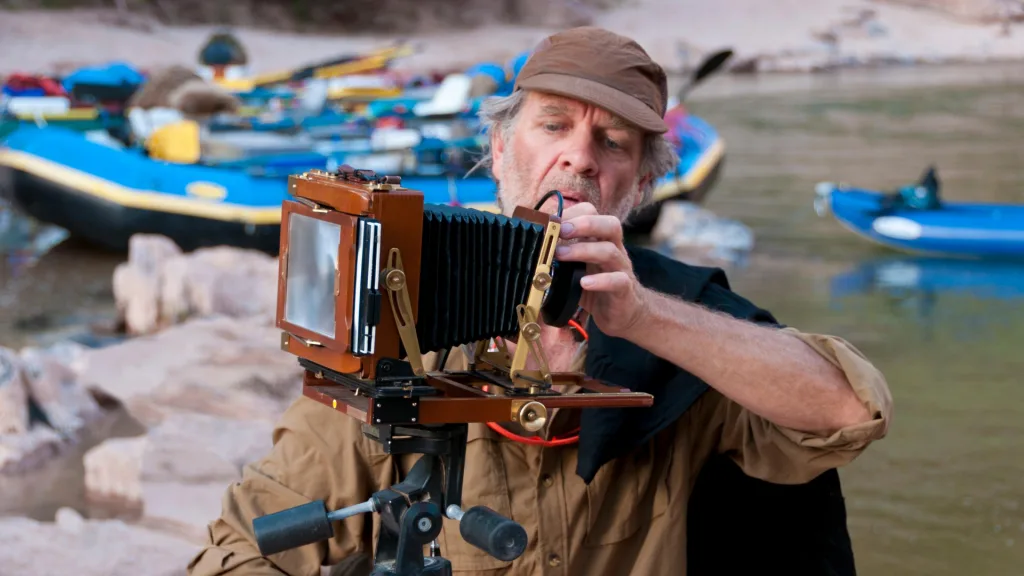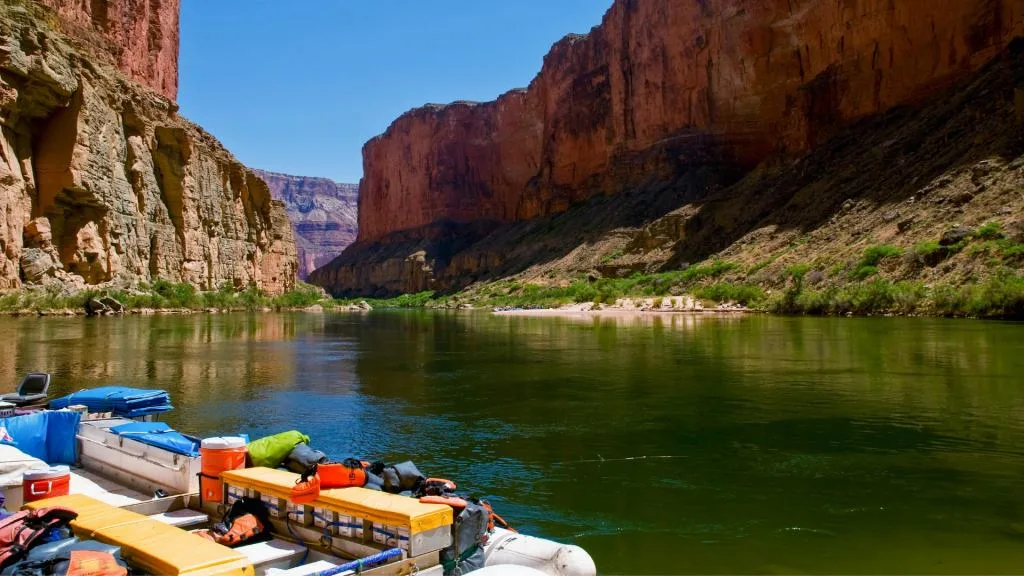The Grand Canyon is an American icon. Generations of US families have visited this natural wonder since it was established as a National Park in 1919. But, most of those visitors overlook the amazing Grand Canyon white water rafting adventures.
Roaring water with refreshing splashes, swirling rapids, and the exciting adrenaline rush of rafting through amazing rock canyons creates an epic experience!
However, these rafting excursions can be as relaxing or wild as you choose.
Today we’re sharing the details and encouraging you to add Grand Canyon white water rafting to your bucket list trips.

The Scoop on Grand Canyon White Water Rafting
What’s the big deal about rafting the Grand Canyon? Well, it’s one of the most exciting ways to see one of the world’s natural wonders. The Grand Canyon is over 277 miles long, up to 18 miles wide, and a mile deep. Rafting through it lets you see parts of the canyon that you can’t reach any other way. It’s not just about the adrenaline rush; it’s about immersing yourself in a landscape that’s been carved out over millions of years.
Rafting Options
There are different ways to raft the Grand Canyon, each offering a unique experience:
- Motorized Rafts: These are large rafts powered by quiet outboard motors. They can carry more people—usually up to 14 passengers—and move faster, allowing you to cover more ground in less time. This means trips are shorter, typically ranging from 3 to 8 days. Motorized rafts are stable and great for those who want to experience the canyon but might be nervous about big rapids.
- Oar Rafts: In these rafts, a professional guide uses long oars to navigate the river. They hold fewer people, usually 4 to 6 passengers, providing a more intimate experience. Oar rafts are quieter than motorized rafts, allowing you to fully absorb the sounds of nature. Trips on oar rafts usually last between 5 to 18 days, giving you ample time to explore.
- Paddle Rafts: Everyone gets a paddle and helps steer the raft under the guide’s instruction. It’s a hands-on and exciting way to experience the river, perfect for adventure seekers. Paddle rafts accommodate about 6 to 8 people and require teamwork, making it a great option for groups. Trips can last from 5 to 12 days.
- Dory Boats: These are small, rigid boats made of wood or fiberglass. They are highly maneuverable and offer a bouncier ride over the rapids. Dories carry 2 to 5 passengers and a guide. They provide a classic river-running experience reminiscent of early explorers. Trips on dories typically last from 12 to 18 days.

A Bit of History
Did you know that the first recorded trip through the Grand Canyon was in 1869? John Wesley Powell, a one-armed Civil War veteran, led an expedition down the Colorado River without any modern equipment.
His journey was fraught with challenges, from dangerous rapids to dwindling supplies. Despite the hardships, Powell’s expedition provided valuable scientific information and maps of the region.
Since then, rafting the Grand Canyon has become a popular adventure. The first commercial rafting trips began in the 1950s, making this incredible experience accessible to the public. Today, over 22,000 people raft the river each year, experiencing the same thrills and awe as Powell did over 150 years ago.
Fun Facts About Rafting the Grand Canyon
- Hidden Gems: There are over 40 major rapids in the Grand Canyon, some with waves as high as 25 feet! Each rapid has its own personality and history, like the infamous Lava Falls Rapid, known for its intense drop.
- Wildlife Watching: The Grand Canyon is home to diverse wildlife. You might spot bighorn sheep gracefully navigating steep cliffs, mule deer grazing by the riverbanks, and even the elusive California condor soaring above. Keep your eyes peeled for ringtail cats and various lizard species sunbathing on the rocks.
- Rock Layers: As you raft, you’ll see rock layers that are over 1.8 billion years old! These layers tell a story of Earth’s geological history, from ancient oceans to volcanic activity. It’s like traveling through time as you move downstream.
Choosing Your Outfitter
Picking the right outfitter is like choosing the right guide for a treasure hunt. You want someone who knows the ropes and makes the trip fun and safe. With over a dozen licensed outfitters, it’s important to find one that matches your preferences and needs.
Types of Trips
- Commercial Trips: These are run by licensed companies that provide guides, gear, and food. Great for first-timers and those who prefer an organized experience. Outfitters handle all logistics, so you can focus on enjoying the adventure. They offer various trip lengths and raft types to suit different tastes.
- Private Trips: Also called “self-guided” trips, these are for the more experienced and adventurous. You’ll need to get a permit through a lottery system and bring your own gear, including rafts, camping equipment, and food. It’s a big undertaking but offers complete freedom over your itinerary.
- Hybrid Trips: Some outfitters offer a mix, where you can bring some of your own gear but still have guided support. This option provides a balance between independence and the security of having professional assistance.
Things to Consider
- Experience Level: If you’re new to rafting, a commercial trip is your best bet. The guides are knowledgeable and can teach you the basics while ensuring your safety. For seasoned rafters, private trips offer a chance to test your skills.
- Group Size: Some outfitters cater to small groups, providing a more personalized experience. Others handle larger groups, which can be more social and fun if you enjoy meeting new people. Consider whether you prefer a close-knit setting or a lively crowd.
- Amenities: Do you want gourmet meals prepared by a river chef, or are you okay with simple campfire cooking? Some outfitters provide extra comforts like cushioned seating, shade canopies, and portable toilets. Decide what level of comfort you desire.
- Guides: Look for companies with experienced and certified guides. Their expertise in navigation, safety procedures, and knowledge of the canyon’s history and ecology can greatly enhance your trip. Don’t hesitate to ask about their qualifications.

Popular Outfitters
Some well-known outfitters include:
- OARS: Known for their eco-friendly practices and excellent customer service. They offer a variety of trip lengths and raft types.
- Western River Expeditions: Specializes in motorized raft trips and provides high-quality amenities, including comfortable sleeping arrangements.
- Arizona Raft Adventures (AZRA): Offers both motorized and non-motorized trips with a focus on education and environmental stewardship.
Remember to read reviews, ask for recommendations, and maybe even call them to ask questions! A good outfitter will be happy to address your concerns.
Choosing Your River Section and Trip Length
The Grand Canyon is divided into sections, and trips can vary from a few days to over two weeks. Selecting the right section and trip length depends on what you want to experience.
River Sections
- Upper Canyon (Lee’s Ferry to Phantom Ranch): About 88 miles long, this section is known for amazing geology and numerous side hikes. You’ll navigate moderate rapids and have opportunities to explore ancient Anasazi ruins and hidden waterfalls. The trip ends with a hike out of the canyon on the Bright Angel Trail, a challenging but rewarding ascent.
- Lower Canyon (Phantom Ranch to Lake Mead): Around 192 miles, this section features bigger rapids, including some of the most famous like Lava Falls and Granite Rapids. The scenery includes stunning views of the inner gorge and opportunities to see rare wildlife. You’ll typically hike into the canyon to start this trip.
- Full Canyon (Lee’s Ferry to Lake Mead): The whole shebang—280 miles of adventure! This option allows you to experience everything the Grand Canyon has to offer, from start to finish. It’s the most comprehensive way to immerse yourself in the canyon’s beauty and challenges.
Trip Lengths
- Short Trips (3-5 days): Great if you’re short on time or new to rafting. These trips usually cover the upper or lower sections and focus on specific highlights. You’ll still experience thrilling rapids and beautiful campsites but with less time commitment.
- Medium Trips (6-9 days): A good balance of river time and exploration. These trips allow for more side hikes and leisurely pacing. You’ll have more opportunities to bond with fellow rafters and delve deeper into the canyon’s wonders.
- Long Trips (10-18 days): For the full immersive experience! These trips cover the entire canyon and offer ample time for relaxation, exploration, and soaking in the serenity of the river. It’s a chance to disconnect from the outside world truly.
What’s Right for You?
Think about:
- Time Available: How long can you be away? Consider work, family commitments, and whether you can take extended time off.
- Budget: Longer trips cost more due to additional days of guiding, food, and permits. Ensure the trip fits within your financial plan.
- Interests: Do you want more hiking or more rafting? If side hikes to hidden waterfalls and ancient ruins excite you, choose a trip that allows time for exploration.
- Physical Demands: Longer trips and those involving hikes in or out of the canyon require a higher fitness level. Assess your physical readiness.

Booking Your Trip
Ready to book? Here’s what you need to know to secure your spot on this incredible journey.
Plan Ahead
- Advance Booking: Trips can fill up fast, sometimes a year or more in advance! Popular dates during peak season are especially competitive. Early booking increases your chances of getting your preferred dates and trip type.
- Peak Season: May to September is the most popular time due to warmer weather and ideal river conditions. However, shoulder seasons like April and October offer cooler temperatures and fewer crowds.
Steps to Book
- Research Outfitters: Use online resources, reviews, and recommendations to find an outfitter that fits your needs. Consider factors like trip length, raft type, and company reputation.
- Choose Dates: Be flexible if possible. Having multiple date options increases your chances of finding an available trip.
- Make a Reservation: Contact the outfitter to reserve your spot. You’ll usually need to make a deposit, which can range from $500 to $1,000 per person.
- Fill Out Forms: Complete any necessary paperwork, including medical forms and liability waivers. Provide accurate information to ensure your safety and comfort during the trip.
- Prepare for Payment: Know when final payments are due, typically 90 to 120 days before departure. Familiarize yourself with the cancellation policy in case your plans change.
Permits
- Commercial Trips: The outfitter handles permits, so you don’t have to worry about the paperwork. This is a significant advantage for those looking for an easy booking process.
- Private Trips: You’ll need to apply through the National Park Service. There’s a weighted lottery system due to high demand and limited availability. Applications are accepted annually in February for the following year.
- Lottery Tips: Increase your chances by applying for less popular launch dates, such as weekdays or off-peak months. Be prepared to be flexible with your dates.
How Much Does Grand Canyon White Water Rafting Cost?
Let’s talk dollars and cents. Understanding the costs involved helps you budget effectively for this adventure.
Price Ranges
- Short Trips (3-5 days): $1,200 – $2,500 per person. These trips offer a taste of the canyon without a significant time or financial commitment.
- Medium Trips (6-9 days): $2,500 – $4,500 per person. You’ll get more river time and experiences for a moderate increase in cost.
- Long Trips (10-18 days): $4,500 – $8,000 per person. These are all-inclusive adventures that provide the most comprehensive experience.
What’s Included
- Guides and Staff: Professional guides who ensure your safety and enhance your experience with their knowledge of the canyon’s history, geology, and ecology.
- Meals and Snacks: Delicious and hearty meals prepared by the guides. Expect a variety of foods, including fresh fruits, vegetables, meats, and even desserts.
- Camping Gear: Many outfitters provide tents, sleeping pads, and sometimes sleeping bags. Check with your outfitter to see what’s included.
- Safety Equipment: Life jackets, helmets (if needed), and first-aid kits are provided to ensure everyone’s safety on the river.
Extra Costs
- Transportation to and from the River: This includes flights or shuttles to the meeting point and from the take-out location. Some trips start and end in different places.
- Gratuities for Guides: Tips are customary and greatly appreciated. Plan on tipping around 10-15% of the trip cost.
- Personal Gear: Items like sleeping bags, wetsuits, and personal clothing are often not included. Some outfitters offer rental options.
- Travel Insurance: Protects your investment in case of cancellations, medical emergencies, or other unforeseen events.
Ways to Save
- Off-Peak Discounts: Consider rafting in April or October when prices may be lower. The weather is cooler, and the canyon is less crowded.
- Group Rates: Some outfitters offer discounts for larger groups, usually starting at eight or more people. Gather friends or family to save.
- Early Booking: Secure early-bird pricing if available. Some companies offer discounts for booking a year or more in advance.
- Last-Minute Deals: Occasionally, outfitters have last-minute openings at reduced rates. This option works if you have a flexible schedule.

Preparing for Your Grand Canyon White Water Rafting Trip
Preparation is key to a successful adventure. Here’s how to get ready physically, mentally, and with the right gear.
What to Pack
- Clothing:
- Quick-Dry Shirts and Shorts: Fabrics that dry quickly are essential since you’ll get wet. They keep you comfortable and help prevent chafing.
- Swimsuit: Wear it under your clothes for easy transitions between rafting and swimming.
- Hat and Sunglasses: Protect yourself from the intense sun. A hat with a strap is ideal to prevent it from flying off.
- Rain Gear: A lightweight waterproof jacket can shield you from unexpected showers and splashes from rapids.
- Warm Layers: Evenings can be cool, so pack a fleece or lightweight sweater.
- Footwear:
- Sandals with Straps or Water Shoes: Secure footwear is crucial for safety on the raft and during hikes. Flip-flops are not recommended.
- Hiking Shoes: For side hikes, bring comfortable and sturdy shoes with good traction.
- Personal Items:
- Sunscreen and Lip Balm: High SPF protection is necessary due to strong sun exposure.
- Reusable Water Bottle: Staying hydrated is vital. Some outfitters provide bottles, but it’s good to bring your own.
- Toiletries: Bring biodegradable soap, toothbrush, toothpaste, and any personal medications. Wet wipes can be handy.
- Optional:
- Camera (Waterproof Recommended): Capture memories, but ensure it’s protected from water.
- Binoculars: Great for wildlife spotting and admiring distant views.
- Journal or Book: Perfect for downtime and reflecting on your experiences.
Physical Preparation
- Fitness Level: While you don’t need to be an athlete, some hikes can be strenuous with steep inclines and uneven terrain. Engage in regular cardio and strength exercises leading up to the trip.
- Health Check: Consult your doctor if you have medical concerns like heart conditions, asthma, or recent surgeries. Ensure your vaccinations are up to date.
- Practice: If possible, try a shorter rafting trip first to get accustomed to the experience. This can build confidence and help you understand what to expect.
Mental Preparation
- Be Open-Minded: Conditions can change due to weather or river levels, so flexibility is important. Embrace the unpredictability as part of the adventure.
- Leave No Trace: Be ready to follow environmental guidelines, such as packing out all trash and minimizing impact on the natural surroundings.
- Disconnect: There’s no cell service, so enjoy being unplugged! Prepare to immerse yourself fully in the experience without digital distractions.
What to Expect When Rafting The Grand Canyon
So, what’s life like on the Colorado River? Here’s a glimpse into your daily adventures.
Thrilling Rapids
- Big Drops: Rapids are rated on a scale of 1-10 in the Grand Canyon, different from the international I-VI scale. You’ll tackle some big ones like Lava Falls (Class 10) and Crystal Rapid (Class 10), which are known for their powerful waves and technical challenges.
- Safety First: Guides will instruct you on how to stay safe, including how to hold on, proper body positioning, and what to do if you fall in. They conduct safety briefings before hitting major rapids.
- Adrenaline Rush: The excitement of conquering rapids creates unforgettable memories. You’ll feel a mix of anticipation and exhilaration as you approach each one.
Side Hikes
- Hidden Waterfalls: Like the beautiful Havasu Falls and Deer Creek Falls, these side canyons offer refreshing swims and breathtaking views. The turquoise waters are a stark contrast to the red canyon walls.
- Ancient Ruins: Explore sites left by Native American tribes, such as the Puebloan granaries and petroglyphs. These historical spots provide insight into the canyon’s early inhabitants.
- Stunning Views: Every hike offers amazing photo opportunities. Trails like Nankoweap lead to panoramic vistas overlooking the river and canyon.
- Varied Difficulty: Hikes range from easy walks to strenuous climbs. Guides will inform you about the difficulty level so you can choose what suits you.

Camping Under the Stars
- Beach Campsites: Sleep on sandy beaches along the river. Setting up camp is a group effort, and you’ll quickly get into the routine.
- Comforts: Outfitters often provide tents, cots, and sometimes even chairs. They set up a “kitchen” area and a designated spot for the campfire.
- Night Sky: With little light pollution, the stars are incredible! You’ll see constellations, shooting stars, and maybe even the Milky Way.
- Campfire Stories: Evenings are spent sharing stories, singing songs, or simply listening to the sounds of the river.
Meals
- Delicious Food: Expect hearty meals like steak, grilled fish, and fresh salads. Guides often surprise guests with baked desserts like cakes or brownies made in Dutch ovens.
- Dietary Needs: Let your outfitter know in advance if you have special requirements. They can accommodate vegetarians, vegans, and food allergies.
- Campfire Atmosphere: Meals are a communal experience. Participating in meal prep or clean-up can be a fun way to bond with others.
- Hydration and Snacks: Plenty of water and snacks are available throughout the day to keep your energy levels up.
Is It Safe to Raft the Grand Canyon?
Safety is a big concern, and rightly so. Let’s address common questions and provide reassurance.
The Good News
- Experienced Guides: Commercial trips have trained professionals who are certified in wilderness first aid and swift-water rescue. Their expertise ensures that risks are minimized.
- Safety Equipment: Life jackets are mandatory and provided for all guests. Helmets are supplied for paddle boat trips or when deemed necessary by the guides.
- Protocols: Outfitters follow strict safety guidelines, including regular equipment checks and emergency procedures. They carry satellite phones or radios for communication.
Statistics
- Low Accident Rates: Millions have rafted safely over the years. Serious incidents are rare, especially on commercial trips where safety measures are in place.
- Rescue Missions: The National Park Service conducts about 300 rescues a year in the Grand Canyon, but most are hikers, not rafters. Rafting rescues are usually for minor injuries or illnesses.
- Fatalities: While any loss is tragic, fatalities on rafting trips are extremely rare. Most are due to pre-existing health conditions rather than accidents.
Past Incidents
While accidents are rare, they can happen:
- Flash Floods: These can occur in side canyons during sudden rainstorms but are closely monitored. Guides receive weather updates and avoid risky areas.
- Capsizing: Uncommon on commercial trips due to the stability of rafts and the expertise of guides. In the event it happens, safety protocols are in place to recover quickly.
- Heat Illness: The sun can be intense, leading to dehydration or heatstroke. Guides monitor guests for signs and encourage regular hydration.
PRO TIP: The Hidden Dangers Inside Grand Canyon National Park
Safety Tips
- Listen to Your Guide: Always follow instructions. They’re there to keep you safe and enhance your experience.
- Wear Your Life Jacket: Keep it on when on the water, snug and properly fastened.
- Stay Hydrated: The sun can be intense, so drink water frequently, even if you don’t feel thirsty.
- Know Your Limits: Don’t push yourself too hard on hikes. Inform your guide if you’re feeling unwell or need to rest.
- Sun Protection: Use sunscreen, wear protective clothing, and reapply as needed to prevent sunburn.
Would You Raft the Grand Canyon?
So there you have it! Rafting the Grand Canyon is an adventure of a lifetime. With the right preparation and a spirit of adventure, you’re set for an incredible journey. Remember, the canyon has been here for millions of years, and now it’s your turn to explore its wonders.
Embrace the thrill, respect the river, and most importantly, enjoy every moment of this unforgettable experience.
Happy rafting!
We’ll Help You Find the Best Free Camping in the USA
You should give it a try!
As a matter of fact, these free campsites are yours to enjoy. Every time you pay federal taxes, you’re contributing to these lands.
Become a FREE CAMPING INSIDER and join the 100,000 campers who love to score the best site!
We’ll send you the 50 Best Free Campsites in the USA (one per state). Access the list by submitting your email below: